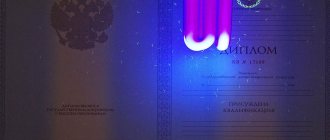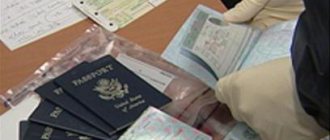One of the reasons why the Government plans to introduce electronic work books is their widespread counterfeiting. At the same time, falsification of a work record by an employee causes problems not only for the employee himself, but also for his employer. To avoid becoming involved in a crime, the employer should distinguish a fake document from a real one. From this article you will learn why employees falsify work books, how they falsify a document, what is the responsibility for falsifying a work book, how to check the authenticity of a document, what are the signs of a fake document, what should an employer do if a fake work book is detected.
What is the purpose of falsifying a work record?
Important! Even if the work book form turns out to be false through no fault of the employee, such a document will not have legal force.
An employee may have a fake work book even because he simply did not know what a document that meets legal requirements should look like. However, most often it is unscrupulous applicants who try to mislead a potential employer. It also happens that the previous employer is at fault because he bought a blank form at a regular kiosk or entered the information inappropriately.
If we talk specifically about attackers, they can pursue various goals by handing over a fake work book to the employer:
- concealment of unpleasant facts (for example, at a previous place of work, an employee violated labor discipline, made a serious mistake or committed an offense, which was recorded in the work book, and now does not want to lose the opportunity to get a similar position);
- new employment (for example, an employee reported in a fake work book that he has work experience and higher qualifications, thereby gaining a chance for employment and an advantageous position in comparison with other candidates);
- registration of a pension benefit (the work book indicates a long insurance period, and therefore a higher pension is assigned).
FORGERY OF A RECORD AS A RESULT OF COMMERCIAL BRIBERY
In addition to the official component inherent in the work book, in our country this document performs another important function during employment. It plays the role of a letter of recommendation, which can influence the decision of a future employer to hire a person. It reflects the reasons for dismissal from previous jobs, as well as information about awards and thanks.
The same arguments are also used by persons applying to commercial organizations to obtain a record of work experience. In this “deal,” the petitioner persuades the assistant, for a fee, to make an entry in his work book, which can help him find a job. Thus, both parties (the petitioner and the assistant) become participants in a criminal act qualified under Art. 204 of the Criminal Code of the Russian Federation “Commercial bribery”.
Article 204 of the Criminal Code of the Russian Federation describes two independent elements of crime: a) illegal transfer of remuneration to a person performing managerial functions in a commercial or other organization (parts 1 and 2); b) illegal receipt of such remuneration (parts 3 and 4).
The fact of a false entry in the work book can be established during operational search activities when one of the parties to the crime (giving or receiving money) contacts law enforcement agencies with a report of a crime being committed. In addition, a false entry in the work book can be detected by a Pension Fund employee when checking the documents provided for calculating a pension.
However, crimes under Art. 204 of the Criminal Code of the Russian Federation, like corruption ones, are latent.
Transfer of bribe.
As a rule, the identification of crimes provided for in parts 1 and 2 of Art. 204 of the Criminal Code of the Russian Federation, occurs on the basis of a statement from a company representative, to whom a person applies with a request to enter information into the work book that does not correspond to reality. This crime is detected much less frequently than the detention of persons who receive bribes (parts 3 and 4 of Article 204 of the Criminal Code of the Russian Federation).
When considering the said application, the investigative body must take measures to establish and assess the presence of elements of a crime that allow qualifying actions under parts 1 and 2 of Art. 204 of the Criminal Code of the Russian Federation. In particular, in order to prove the objective side of the crime, it is necessary to find out and record: - intentions to transfer money or provide services for illegally entering false information about work activity into the work book in the interests of the giver; — conditions for the transfer of property or provision of services (place, time, method of transfer of money), including measures to disguise it; — voluntariness of filing a complaint about commercial bribery; - damage caused by commercial bribery.
The actions of a person who proposes to add false information about work activity to the work book are carried out only with direct intent. That is, he understands the illegality of transferring money or other property to someone who performs managerial functions in an organization for performing an action (inaction) in his interests and wants these actions to be performed. Despite the fact that the motive for committing a crime does not affect qualifications, it must be established. That is, you need to find out why the briber subsequently wanted to use the work book with a false entry.
To investigate the case, it is also important to find out: - the relationship between the subjects of the crime; - the circumstances of their acquaintance and establishment of contacts, ways of forming and maintaining relationships; — the environment surrounding commercial bribery; - the circumstances of the conspiracy regarding the transfer, receipt as a gift of money, valuables, etc., the role of the organizer and other participants.
Finally, in the process it is necessary to establish: - the exact name of the organization, the subject and purpose of the activity, the conditions and procedure of work, regulatory materials governing them (charter, rules, instructions, orders, instructions, etc.); - the position of the person to whom bribery is offered, the period of work in it, the range of responsibilities (with special attention to the presence of the authority of this person to hire and dismiss), regulatory materials governing his activities.
FROM PRACTICE.
On October 26, 2010, the Neman City Court of the Kaliningrad Region passed a verdict against K. The convict intended to officially find employment at Stroy-West LLC. He knew that one of the conditions for employment is the presence of work experience in the construction industry, recorded in the work book. To prove his length of service, K. turned to the director of NemanStroyServis LLC with a request to make a fictitious entry in his work book about working for the LLC for a fee. After the agreement, while in the office of the director of NemanStroyServis LLC, K. handed over to the director his work book and money for performing actions in his interests, expressed in the latter making a fictitious entry in the work book (case No. 1-90/2010).
Receiving a bribe.
Bribery, like taking a bribe, is a crime that is usually detected little more easily than the reverse process.
This is due to two reasons. Firstly,
information that an official of a commercial organization makes false entries in the work book for money can be verified during an operational investigation (operational experiment, observation, wiretapping of telephone conversations). Actions to make a false entry are, as a rule, one-time and it is extremely difficult to prove after the fact the fact of transfer of funds for the service provided.
Secondly,
information about the person who offers commercial bribery comes only from the person who is offered a reward for illegal actions. The appearance of such information by law enforcement agencies depends on the integrity of the person who was approached with a proposal to forge a work record book. At the same time, information about a person who takes money for entering false information in a work book may come not only from a person who initially decided to commit a crime and then abandoned it. It can be obtained during operational search activities, and can also be provided by the security services of companies that screen applicants for vacant positions.
An operational investigation to record the fact of receipt of commercial bribery can be initiated either at the request of a person who contacted a law enforcement agency with a report of a crime, or based on information from the law enforcement agency itself as part of an operational accounting case.
FROM PRACTICE.
The Pachelmsky District Court of the Penza Region, with a verdict dated August 18, 2015, convicted K. honorably. 3 tbsp. 204 of the Criminal Code of the Russian Federation. K. served as chairman of the Ararat Union of Industrialists and Entrepreneurs. He had the authority to hire and fire workers. In May 2015, S. approached him with a request to make entries in his work book stating that he allegedly worked at the Ararat SPSPC. Inside his car, K. personally made entries in S.’s work book under numbers 1 and 2, containing information that did not correspond to reality: about S.’s acceptance into the Ararat SPSPC and about S.’s dismissal at his own request. After which he received money from S., but was immediately detained by officers of the Russian Department of Internal Affairs in the Pachelmsky district. As follows from the case materials, S. initially approached K. with a request to make false entries in the work book provided to him, so that this would help him get a job in one of the companies in the Moscow region. The crime would have been committed and would have remained undetected if S. had not had a conversation with his friend T., who convinced him of the illegality of his actions and persuaded him to contact law enforcement agencies. After the police officers accepted the statement from S., operational search activities were carried out, in particular an “operational experiment”. Before it began, S. was examined. Then the operatives gave him money and inspected his work record, which recorded the absence of records of work at the Ararat SPSPC. Then S. was given the means to make an audio recording. After carrying out the operational investigation, police officers, together with employees of the Investigative Committee of Russia, again conducted a personal search of S., who voluntarily issued a work book with records of work at the Ararat Specialized Industrial Union and an audio recording device. The operatives also inspected the scene of the incident - K.'s car, during which money received as a commercial bribe was seized. Based on the data obtained as a result of the operational investigation, evidence was generated, which subsequently formed the basis for the conviction (case No. 1-39/2015).
When receiving information from operational sources about the facts of entering false information into work books, employees of operational units, as a rule, plan and conduct several operational operations “operational experiment” with the participation of different persons. Carrying out several similar types of operational investigations is necessary to eliminate the element of provocation and obtain information that the illegal actions of the head of a commercial organization are the norm for him, and not the exception to the rule.
FROM PRACTICE.
By the verdict of the Kamensky City Court of the Penza Region dated September 30, 2013, D., director of Kholodtorgtekhnika LLC, was convicted. Information that D. had committed illegal actions came to the police from operational sources. In order to verify this information, operational search activities were planned and carried out with the participation of two individuals, with a significant gap in time. This was necessary to prove that D. systematically received money for making false entries in work books. As a result, the operatives recorded two episodes of crime, when D. illegally, with his own hand, entered false information into the work books of B. and V. - 06/27/2015 and 08/26/2015. For these crimes provided for in Part 3. Art. 204 of the Criminal Code of the Russian Federation, D. was sentenced to 2 years and 6 months of suspended imprisonment with a fine of 40 thousand rubles. (Case No. 1-114/2013).
How do citizens falsify work records?
Forgery of a work book can be done in several ways, namely:
- a person can purchase from scammers a fake seal of an existing or non-existent organization;
- you can agree with a commercial company that is periodically transforming to have a seal put on it;
- it is possible to make a false entry in the work book;
- you can replace a legally issued work book;
- some replace several sheets of a document;
- False entries are often made (most often the employer enters information about an employee who does not actually work for the company).
Why is TC faked?
Because of the same thing as other documents: to either hide some facts or document non-existent ones.
Usually, falsifying a work book to get a job has the purpose of:
- assign false seniority and experience to obtain the desired position;
- hide unwanted information about your previous place of work, for example, dismissal at the initiative of the employer.
It happens that false information is discovered when applying for a pension - fake entries were made to increase the length of service. Or old incorrectly completed records have been found, due to which years of work are lost, and the temptation also arises to see if it is possible to falsify the work book retroactively in order to restore what was lost.
Forgery of a work record: what the law says
Important! If the employer, after he hired a new employee, discovered that the work book was fake, and the employee quit before the circumstances were clarified, he is considered guilty of forging the document.
According to current legislation, an employer who certified a fake work book must pay a fine. However, if he is able to prove his non-involvement in the case (after all, the law does not oblige employers to check the authenticity of the documents submitted by the employee), the court will probably not oblige him to bear financial responsibility.
With an employee who handed over a false work book to the employer, the law allows the employment contract to be terminated, but it is necessary to prove his guilt. Because if a fake book was issued by a previous employer, the employee needs to issue a new document, help in collecting certificates from previous places of work and be allowed to continue working.
| Employee Responsibility | Employer's liability |
| Mandatory forced labor lasting up to 240 hours; arrest for a period of 6 months; executive works for a period of up to 2 years; imprisonment for 2 years. | A fine of up to 200 current minimum wages (after an inspection, if fraud, production of counterfeit books, or forgery is discovered). |
Actions
If a manager or authorized person discovers a fake document, this fact cannot be ignored. Otherwise, the unresolved problem will result in a big conflict with the relevant authorities.
The employer has no right to hire a citizen and not make entries. It is also impossible to refuse employment because of such a document. It is necessary to find out from the employee himself whether he is aware that his work record has incorrect records or simply does not meet the regulatory requirements.
Then you can act depending on the situation. If an employee is not aware that his work record does not meet the standards, then this issue will need to be resolved with the previous employer. In the case where there is only one entry in the labor record and a short work history, it can be replaced with a new official one. In other cases it is necessary:
- Demand that the previous employer fill out the document correctly.
- Request that incorrect entries be corrected.
- Issue a duplicate of the form.
The situation is more complicated when a citizen, independently or with the help of third parties, has drawn up a work record or made entries in it. Is there liability for falsifying a work record? Yes, but the manager must first report this fact to any of the authorities (the prosecutor's office, the police or the labor inspectorate).
It is impossible to dismiss an employee based on the discovery of a fraudulent employment record until it is proven. Further, the citizen can be dismissed under clause 11, part 1, art. 81 Labor Code of the Russian Federation.
Forgery of a work record: how to recognize a fake document
Important! The employer should pay attention to work records, since it is much better to recognize a false document from the very beginning than to later prove non-involvement and bear financial responsibility.
You should pay attention to the following things that indicate that the document is not genuine:
- compositional or mechanical traces of counterfeit are visible;
- there are logical contradictions in the records;
- a non-standard font was used;
- there are spelling errors;
- the color of the forms is different;
- crossed-outs, blots, and corrections are found that are not permitted by current labor legislation;
- no seal.
| Document type and size | There are 3 versions of the work book - a sample of 1938, 1974 and 2003:
|
| Printing house | On the final page is the name of the organization that published the book. On a document from 1974, “Gosznak 1974” is put (sometimes the language of the republic is also indicated), and on the TC of 2003 there should be a sign “MPF Gosznak 2003”. |
| Work book form | Material - cardboard (old books), vinyl or calico; image of the coat of arms of the Russian Federation or the USSR; pages are unlinked; There is a cover page with information about the employee. |
| Sheet numbering | If the page numbering of the document is incorrect, it means that the sheets have been pulled out. If some pages are different in number color, font or color, then the pages have been replaced with others. |
| Series and number | The 1974 document contains a single red number on ten pages: 1, 5, 9, 13, 17, 21, 25, 29, 33, 37. In the 2003 book, numbers are written in black ink on 11 pages: 1, 3, 9, 15, 19, 23, 27, 31, 33, 37, 39. The series must match the year the document was issued (see the following table). |
| Watermark | The 1977 example has a wavy line watermark on all but the outer 2 pages. The 2003 sample has a “TK” watermark in various colors and a fine mesh. |
| Identifiers | Depends on the year in which the documents were issued. It is enough to compare 2 books of the same type to notice that the difference in the identifier lies only in the different dates of creation of the document. |
How to check a document series:
| A series of documents | Year of issue |
| AT-I | 1974-1976 |
| AT-II | 1977-1979 |
| AT-III | 1980-1982 |
| AT-IV | 1984-1985 |
| AT-V | 1986-1989 |
| AT-VI | 1990-1992 |
| AT-VII | 1993-1997 |
| AT-VIII | 1997-2000 |
| AT-IX | 2001-2003 |
| AT-X | 2003 |
| TK | 2004-2005 |
| TK-I | 2006-2007 |
| TK-II | 2008-2009 |
| TK-III | 2010 |
See how to find your serial number, watermark, and other markings ⇒ here.
Responsibility
What responsibility does a citizen bear for falsifying a work record? Forgery of a document entails criminal liability.
When clarifying the circumstances, the reasons that entail a court decision are identified.
If the actions of a citizen who produced counterfeits were put on stream, then he will face a rather severe punishment.
If a person only used a fake document, then a fine of up to 80 thousand rubles may be imposed on him, and the citizen may be sentenced to forced labor for up to two years. And despite the fact that he did not produce a fake document, he carried out activities using it and received money for it.
So, what does falsifying a work record involve? Responsibility for marketing and counterfeiting is as follows:
- Restriction of freedom up to 24 months.
- Forced labor for up to 24 months.
- Arrest for up to six months.
- Imprisonment for up to 24 months.
If an official is involved in the process of falsifying and selling a document, he is punished:
- A fine of up to 200 minimum wages or the amount of earnings for two months.
- Mandatory work from 180 hours to 240 hours.
- Correctional labor for up to 24 months.
- Imprisonment for up to 24 months.
If the fact is revealed that the employer made a mistake and has nothing to do with the offense, his organization may be subject to a prosecutorial audit or inspection by the inspectorate.
Common mistakes
Error: The employee whose employment record was found to be fraudulent was immediately fired.
Comment: An employee can be fired for falsifying a work record book only after his guilt has been proven in court.
Error: The employer produced a duplicate work record book, which turned out to be fake when the employee was hired.
Comment: A duplicate cannot be issued, since the original work book contained unreliable entries.
How to counterfeit
For a certain period of time, work books were freely available for sale, which allowed them to be produced by any organization. Many employers required their newly arrived employees to bring blank employment forms or inserts with them.
In order to falsify a work record or an entry in it, it was necessary to find any organization that was transformed periodically. Choose a moment after the reorganization, but before the liquidation of the company stamp.
At the time of the free sale of employment forms, there was no control over the activities of personnel employees, and employers kept old seals for providing such services.
In some cases, after purchasing the form, a stamp was made (such services were inexpensive). A citizen could independently or with the help of friends fill out the employment form and make the necessary entries, certifying everything with seals. Today, a fake work book or falsifying entries in it using this algorithm are impossible due to widespread control. In addition, in case of official employment, the employer himself provides the work permit.
Currently, official forms are fundamentally different from fake ones, so it is quite easy to expose the deceivers. And if citizens present a fake document, then, apparently, they do not know how serious the forgery of a work record book is.
Motives for employees to provide counterfeit books
You may receive a forged employee work book
- The employee submitted the technical documentation in good faith, assuming that it was in proper order and being mistaken that it was fake, that is, it did not meet the established criteria.
- The employee knowingly presented a counterfeit book, fully participating in its forgery or acquisition.
In the first case, the situation may develop due to the short-sightedness of the employer, who purchased the employment form in the wrong place and filled it out. In some cases, the following forms:
- if filled out incorrectly;
- if a seal is not affixed upon dismissal;
- in the absence of a signature or its decryption,
in principle cannot be considered a document. If an employee brings you work of similar quality, it is unacceptable to accept it into personnel records.
In the second case, the labor document may meet all the criteria externally, but be fake. A counterfeit labor code may appear in an employee:
- By purchasing from unknown persons.
- In agreement with an employer for whom he did not work, but who provided him with a fake book filled out as required.
- If you purchase the form yourself and make an entry, possibly without affixing a stamp.
In these cases, falsification is done deliberately in order to obtain documents reflecting higher qualifications, required experience or other advantages.
The employee believes that he will be able to mislead the employer and gain priority in considering his candidacy as an applicant.
Working on someone else's document
Working on someone else's document, like falsifying a work book, the responsibility for which was discussed earlier, does not bring anything good. And the employer’s attempt to turn a blind eye to such a step on the part of the employee will not end well for the former.
Firstly, where is the guarantee that a couple of years after employment an employee will not come and demand to establish the length of service for pension accruals? And even if the employee does not achieve what he wants, the employer may experience many unpleasant moments from litigation.
Secondly, no one can reliably know the origin of such a work record. In practice, personnel officers hired a person with someone else's book, while the true owner of the work book was dead.
Thirdly, an employee who treats a colleague unkindly can report such a situation to the authorities, which will entail criminal liability. And it will be very difficult to protest the fact of document forgery.
How to change an employee's full name in the employment record
If the employee has changed his full name, correct the entry on the title page. Cross out the previous last name, first name or patronymic with one line, then write down the new data.
Corrections cannot be made based on the employee’s words. Changes can be made only on the basis of a passport, marriage or divorce certificates, and other documents. It is mandatory to refer to their number and date. On the inside cover of the work book, write the basis document, put the signature of the person responsible and the employer’s seal, if any.
Fake entry
In some cases, you may suspect fraud by identifying the entry as improper. How to check an entry in a work book? According to these criteria:
- The entry was not made in accordance with the form or in accordance with the Instructions and Rules.
- The seal has not been supplied, or the supplied seal does not meet the requirements.
- The record contains blots and corrections that are not regulated by the Labor Code of the Russian Federation.
Any doubt about the authenticity of the employment contract must be confirmed or refuted, since accepting such an employee, as well as not accepting him, imposes a certain responsibility on the employer.
What are the consequences of a fake entry for an employer?
Interaction with a fake TC or record must be legalized. Otherwise, lack of vigilance on the part of the employer may lead to penalties from inspectors from the labor inspectorate.
Moreover, you can get into serious trouble for falsifying documents yourself, even if you just continue to make entries in a fake book or apply for a job after a deliberately unlawful dismissal record.
Sizes and types
The work book has three possible years of issue . Books from 1938 cannot be counterfeited; in any case, there have been no identified precedents. In addition, they have practically gone out of use. Cases of their use are few.
Basically, we can talk about fake TC:
- 1977 release;
- 2003 release.
Please note that these books vary in size and cover structure.
In some cases, uninformed young entrepreneurs doubt the authenticity of the labor document if it differs in size from others.
Keep in mind that it is normal if they are of different vintages.
Possible dimensions of the work book in centimeters and by number of pages:
- The 1977 TC has dimensions of 10 x 14 cm. The number of pages is 40.
- The TC of 2003 has dimensions of 8.8 x 12.5 cm. The number of pages is 44.
Errors in award information
For most employees, this section is empty, since this place contains information about awarded diplomas, certificates, titles, and other awards. Therefore, awards pages often end up with unnecessary information. In this case, the responsible person recognizes the entries as invalid, signs, puts a seal (if any) - in general, acts according to the general rules.
You must act in the same way if there is an inaccuracy in the dates, details of the foundation document, company name, or other data.
Ways to create a fake document
The most common are the 1974 and 2003 "linden" ones. Their high degree of prevalence is due to the fact that for a certain period of time (late 1990s - early 2000s) they could be freely purchased at any stall. Then we looked for a company that was undergoing a planned transformation. Immediately after the transformation, a fictitious entry was made and certified by the old seal, which they did not have time to liquidate.
The most common fake work books are those from 1974 and 2003.
At that time, control over the personnel system was not very strict, so some companies even provided services that contributed to the creation of “lips”.
Another method was to have a company seal made. It was quite cheap and relatively accessible. The owner of an empty book filled out its title page, made the necessary fake entries and certified it all with a forged seal and signature.
Due to the existing strict monitoring of personnel records, it is practically impossible to fake a labor document, however, those who are still doing this use similar algorithms.








